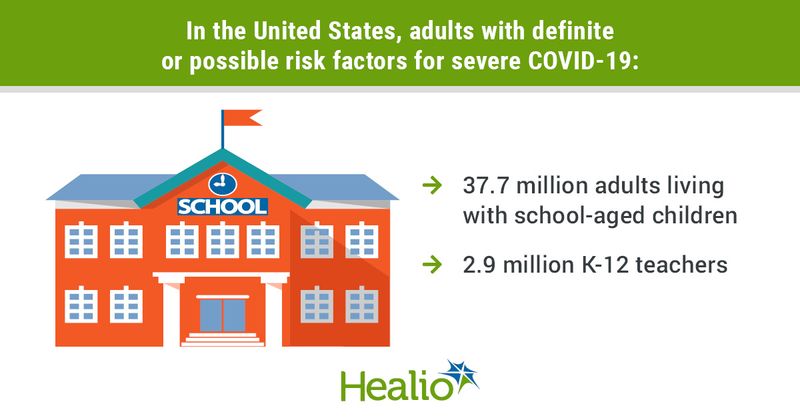40 million teachers, adults living with schoolchildren at risk for severe COVID-19
Approximately 37.7 million adults living with school-aged children and 2.9 million K-12 schoolteachers have definite or possible risk factors for severe COVID-19, according to research published in Annals of Internal Medicine.
“Children, it is often noted, are at low risk of severe COVID-19 disease,” Adam W. Gaffney, MD, MPH, an instructor in medicine at Harvard Medical School, told Healio Primary Care. “However, children can transmit the virus — potentially putting adults who work or live with them at risk.”

Gaffney and colleagues analyzed data from the nationally representative 2018 National Health Interview Survey.
The researchers estimated the prevalence of “definite” and “possible” risk factors — as defined by the CDC — for severe COVID-19 in employed adults who were not teachers, adults who were teachers, and adults who lived with school-aged children.
They evaluated the differences in the prevalence of these risk factors among adults who lived with children based on their age, race/ethnicity and income.
The study included 14,097 adults representing 150.3 million non-teachers in the U.S., along with 592 adults representing 5.8 million primary, secondary and special education teachers, and 5,682 adults representing 69.7 million adults living with school-aged children.
Gaffney and colleagues determined that among U.S. teachers, 39.8% (weighted n = 2.32 million; 95% CI, 1.98-2.66 million) had a definite risk factor for severe COVID-19, and 50.6% (weighted n = 2.95 million) had definite or possible risk factors.
Among employed non-teachers, the researchers determined that 41.4% had definite risk factors and 55.8% had definite or possible risk factors for severe COVID-19.
The researchers found that among adults living with school-aged children, 41% (weighted n = 28.61 million; 95% CI, 27.03-30.2 million) had a definite risk factor, and 54% had definite or possible risk factors (weighted n = 37.7 million). These adults included 2.5 million adults older than 64 years, 4.67 million who had heart disease, 4.84 million who had type 2 diabetes and more than 600,000 who had cancer.
The prevalence of risk factors was similar for adults living with younger and older children, according to the researchers.
Gaffney and colleagues also determined that adults living with children in low-income households were more likely to be at risk than those living in high-income households.
In addition, adults living with Black children were more likely to be at risk than other adults.
“Black children, and children from low-income families, both have more to gain and to lose from school reopenings,” Gaffney said. “On the one hand, in-person education is especially important for children from disadvantaged backgrounds, in terms of educational and social development and health. On the other hand, however, the adults they live with are at especially increased risk of severe complications from COVID-19, as we found in our study.”
The study authors noted that while resuming in-person instruction is “critical” for children’s health, development and welfare, doing so without safeguards would put vulnerable adults at risk for severe COVID-19.
“An important aspect of school reopenings is community control of viral dissemination,” Gaffney stressed. “If coronavirus is rampant in the community, it's going to be impossible to keep it out of the schools. Additionally, smaller classes, adequate PPE for teachers, and ramped-up capacity for testing may help protect schools.”

